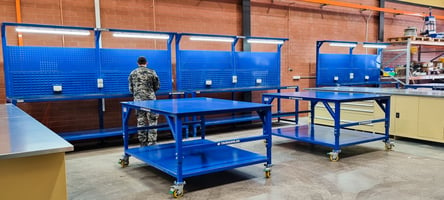Last month, Tradesales received a visit from representatives of the Wheatbelt Development...
The team here at Tradesales are more than familiar with the importance of an adjustable workbench. After all, with industry experience and expertise in complete turnkey workshop upgrades and fit-outs, we’ve helped many, many customers find the right workbench for their particular needs.
Of course, not all workbenches are equal, and, moreover, not all uses of benches are the same. Having a height-adjustable workbench is essential for ensuring ergonomic activity and efficient productivity. But what height exactly is best? How do you find the right type of workbench for you?
Let’s dive straight in.
Why an adjustable workbench is important
Health and Safety
As providers of equipment and machinery to support the entire life cycle of our customers' assets, we intimately understand just how important it is to ensure the workplace health and safety of our customers' teams. From manufacturing to workshop activity, ensuring that your workers are operating safely and to regulation standards are vital.
Having an adjustable workbench allows your team to change the height of their workbench to suit not only their own needs but also the specific needs of the job at hand. While we’ll get into the weeds on this a little later, different tasks may require different workbench heights, and having the adjustability to adapt your workspace to that need is going to pay dividends.
Productivity
While health and safety are the top priority, having an adjustable workbench has other advantages. The better your equipment facilitates good working practices, the more productive and efficient your team is going to be.
A height adjustable workbench allows workers to best utilise their machinery and tools without having to worry about moving to a different workspace. While this might seem like a small benefit, it can crucially make an outsized impact on the overall output of your workshop.
Understanding Ergonomics
If the ergonomics of your workbench set-up is not correct, you’ll find that you or your team will begin suffering everything from lower back pain to decreased productivity.
The term ergonomics refers to the design of items so that people can use them in the safest and most efficient manner possible. During our years providing high-quality equipment and fit-outs to customers across the construction, mining, engineering and manufacturing industries, we’ve seen our fair share of badly designed worksites and workshops.
An adjustable bench allows workers to change the height of their benches according to their needs or the needs of the task at hand. It should go without saying that adjustable benches will only prevent injury if other basic safety practices are followed, such as avoiding excessive bending or safe tool operations.
Nonetheless, with a customisable workbench with an adaptable height, you’ll be able to both reduce the risk of injury and increase the rate of productivity.
How to choose the best workbench height for you
There are two main considerations to take into account when you’re looking to adjust or set the height of your workbench; Your height and the type of work you are doing.
1. Your height
The second consideration you need to consider is choosing the right height for your workplace based on the tasks being completed. Your own height will be the most important factor in determining the correct positioning of your workbench. Getting this right will ensure you avoid injury as much as possible and enjoy an ergonomic workstation.
2. Your tasks
The second consideration you need to look into is choosing the right height for your workplace based on the specific tasks being completed. If you’re manufacturing or working in construction, you’ll need to exert force when using a hammer, screwing or otherwise working on machinery and objects. This requires good foot placement for leverage that a high workbench may not be able to provide.
By comparison, computer work may require longer standing periods, and ensuring your workbench is high enough will help you stand with the right posture that can be maintained for longer periods without causing pain, fatigue, or injury
Fortunately, with height-adjustable workbenches, one handy workspace can be customised for different users and different tasks.
What is the best height for a workbench?
Standard Workbench Height
As you can imagine, determining the best standard height for a workbench is like outlining the optimal length of a piece of string.
There are however standard metrics that can help direct you towards finding the optimal height for you or your team. If you’re engaged in construction or manufacturing–such as joinery–keep the top of your bench in line with your shirt cuff’s bottom edge.
This allows for maximum ergonomics, productivity, safety, and comfort.
High Leverage Jobs
If you’re operating hand or power tools that require more leverage and power, you’ll probably need to drop the workbench a few centimetres. A good guide is to stand beside your workbench and let your arms dangle by your side in a relaxed position.
Your adjustable workbench top should reach the height of the first knuckle on your thumb. This will give you a good posture for getting the job done without injuring your back or being too low or high.
Looking for the right workbench? We’ve done the work for you!
The Tradesales sales and service team are passionate about finding the perfect solution for all of our customers’ needs. With high quality, durable and–most importantly–height adjustable workbenches available, we’ll make sure that you and your team are best positioned for optimal work and output.



